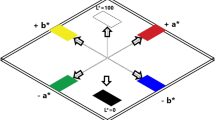Abstract
A method is proposed which comprises placing a portland cement concrete or mortar sample with a harmless solution, based on a variety of anthocyanins, which acts as an indicator yielding a color which is visibly different in zones where an alkaline reserve exists (pH ~ 12) (green) from that observed in carbonated areas (pH ≤ 9) (blue). We firstly experimented with various solutions containing anthocyanins extracted from flowers and fruits, after which food colors commercialized in the European Union were utilized seeking to prepare a reproducible method. The tested products are three food colors coming from grape, black carrot and red cabbage obtained by means of extraction and later dehydrated by spray dying. The solutions which seem most appropriate to us contain 2.5% of color dissolved in a liquid where alcohol and water are mixed at a 70/30 ratio.








Similar content being viewed by others
References
Taylor HFW (1997) Cement chemistry. Thomas Telford, London
Verbeck GJ (1958) Carbonation of hydrated Portland cement. ASTM Spec Tech Publ 205:17–36
Alekseev SN, Rozental NK (1976) The rate of concrete carbonation. In: Carbonation of concrete. RILEM International Symposium, Cement and Concrete Association
Ngala VT, Page CL (1997) Effects of carbonation on pore structure and diffusional properties of hydrated cement pastes. Cem Concr Res 27:995–1007. https://doi.org/10.1016/s0008-8846(97)00102-6
Stefanoni M, Angst U, Elsener B (2018) Corrosion rate of carbon steel in carbonated concrete—a critical review. Cem Concr Res 103:35–48. https://doi.org/10.1016/j.cemconres.2017.10.007
CPC-18 (1988) Measurement of hardened concrete carbonation depth. Mater Struct 21:453–455. https://doi.org/10.1007/BF02472327
CEN_COMITÉ_EUROPÉEN_DE_NORMALISATION (2006) Products and systems for the protection and repair of concrete structures—test methods—determination of carbonation depth in hardened concrete by the phenolphthalein method. BS EN 14630:2006
EUROPEAN_PARLIAMENT_AND_COUNCIL (2008) On classification, labelling and packaging of substances and mixtures, amending and repealing Directives 67/548/EEC and 1999/45/EC, and amending Regulation (EC) No 1907/2006. vol REGULATION (EC) No 1272/2008
Chinchón-Payá S, Andrade C, Chinchón S (2016) Indicator of carbonation front in concrete as substitute to phenolphthalein. Cem Concr Res. https://doi.org/10.1016/j.cemconres.2015.12.010
Chinchón_Payá S, Chinchón_Payá E, Chinchón_Yepes J, Andrade_Perdrix M (2017) Utilización de un indicador inocuo, basado en pigmentos naturales orgánicos, en procesos de carbonatación del hormigón. Spain Patent 2579063_B1
THE_EUROPEAN_COMMISSION (2012) COMMISSION REGULATION (EU) No 231/2012 of 9 March 2012 laying down specifications for food additives listed in Annexes II and III to Regulation (EC) No 1333/2008 of the European Parliament and of the Council
Chinchón S, García J, López-Atalaya M et al (2004) Cement paste colouring in concretes. Cem Concr Res 34:1987–1991. https://doi.org/10.1016/j.cemconres.2004.02.023
Linares L, López-Atalaya M, Chinchón S (2009) Cement content determination through selective stain in hardened concrete. Cem Concr Res 39:1105–1109. https://doi.org/10.1016/j.cemconres.2009.07.016
Acknowledgements
The products have been provided by the company SECNA (Sociedad Española de Colorantes Naturales y Afines-Spanish Natural Color Society) to whom the authors express our gratitude.
Author information
Authors and Affiliations
Corresponding author
Ethics declarations
Conflict of interest
The authors declare that they have no conflict of interest.
Additional information
Publisher's Note
Springer Nature remains neutral with regard to jurisdictional claims in published maps and institutional affiliations.
Rights and permissions
About this article
Cite this article
Chinchón-Payá, S., Andrade, C. & Chinchón, S. Use of anthocyanin solutions in portland cement concrete to identify carbonation depth. Mater Struct 53, 101 (2020). https://doi.org/10.1617/s11527-020-01518-4
Received:
Accepted:
Published:
DOI: https://doi.org/10.1617/s11527-020-01518-4




